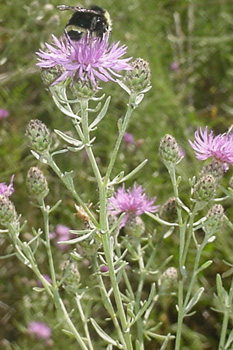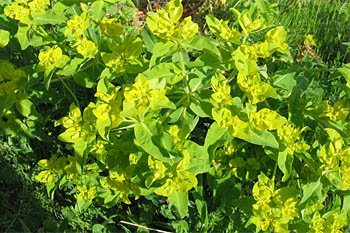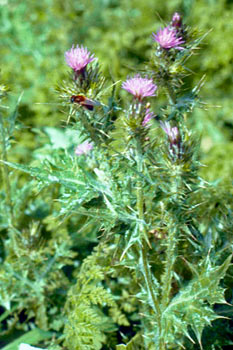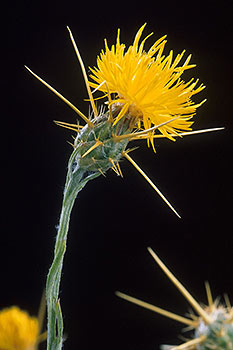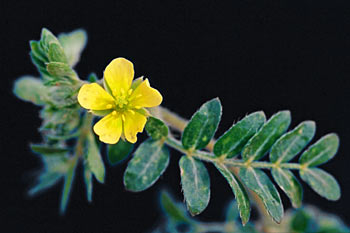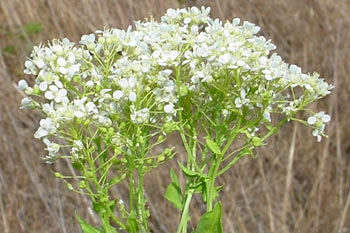Salmon River Restoration Council
- Overview
- History
- Weed Spotlight
- Weed ID Guide
- Program Contact
Overview
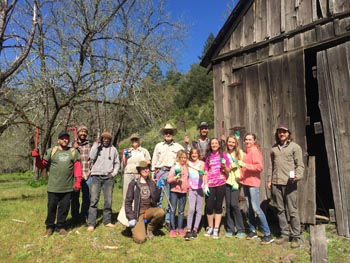 SRRC crew, schoolkids and volunteers dig Italian thistle.
SRRC crew, schoolkids and volunteers dig Italian thistle.The Salmon River Restoration Council has been involved in noxious weed management since the early 1990’s. Our Noxious Weeds Program promotes manual removal, mulching, and other non-chemical methods of invasive plant control throughout the watershed.
The program focuses on the inventory, mapping and removal of the following noxious weeds:
- Spotted knapweed
- Meadow knapweed
- Diffuse knapweed
- Oblong spurge
- Marlahan mustard (dyer's woad)
- Yellow starthistle
- Malta starthistle
- Italian thistle
- Canadian thistle
- Sulfur cinquefoil
- Scotch broom
- French broom
- Spanish broom
- Puncture vine (goathead)
- White top (hoary cress)
- Tree of heaven
- Houndstongue
We employ local crews and community volunteers to treat invasive plant populations without using pesticides.
The success of the program relies on a strong community volunteer component and a commitment to chemical-free control. Our community-based effort is recognized as one of the most effective watershed scale weed control programs in the country. Our Salmon River Cooperative Noxious Weed Program Strategy for Restoring Native Plant Communities - An Action Plan for the Salmon River Restoration Council is a guide for the successful implementation of our program.
History of the Cooperative Noxious Weed Program
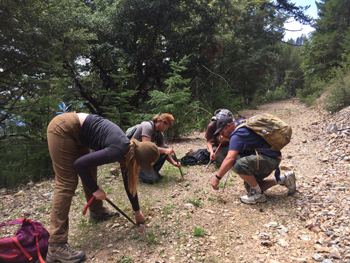 Weed crew dig knapweed out of the road to Haypress Mdws
Weed crew dig knapweed out of the road to Haypress MdwsBeginnings
Recognizing the need for a coordinated, collaborative approach to noxious weed control in the Salmon River watershed, the SRRC initiated a community-supported program to eradicate weeds in 1994.
Initially the focus of the program was on Scotch broom, Spanish broom, and Marlahan mustard. In order to safeguard the health of aquatic ecosystems and work crews, no chemical herbicides were used.
Good progress was made on reducing populations of these weeds, especially Scotch and Spanish broom.
This early success reinforced the idea that federal land managers, private landowners and other stakeholders could work together to achieve watershed-level noxious weed control.
Spotted Knapweed
Two noxious weeds, spotted knapweed and diffuse knapweed were first discovered on the Salmon River in 1997. Both probably arrived in the watershed during the wildfires of 1987, inadvertently brought in with fire fighting equipment and personnel.
Both knapweed species are rated as a Class A Pest by the State of California. This mandates eradication or containment of the weeds. At the Salmon River, local land managers planned the use of synthetic herbicides to control knapweed along roads and river bars.
The SRRC and local community was averse to the idea of spraying chemical herbicides around the river and tributaries. Many herbicides are toxic to aquatic life even at very low concentrations.
In response, the SRRC launched a very successful knapweed control program that completely avoided the use of chemical herbicides. Our program uses manual control methods to remove the weeds. Detailed inventory, tracking, monitoring, mapping, and coordination provide the structure needed to obtain results.
Knapweed has been significantly reduced or eliminated at over 260 sites throughout the watershed. A recent US Forest Service survey was unable to find any knapweed plants producing seed.
Other noxious weed control programs have been modeled after ours.
Roadside Weed Control
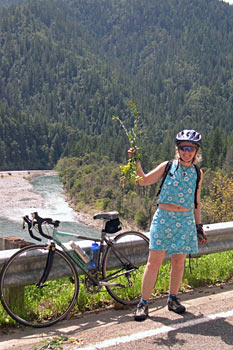
"Bikers That Care" Pulling Weeds
In 2000, SRRC started to help control Marlahan mustard and other weeds along roads in the Salmon River. Drivers and cyclists are educated on weed identification and control techniques and are then encouraged to engage in spontaneous (and organized) acts of weed removal along our roads.
As a result, Marlahan mustard infestations have been significantly reduced along the county road between Etna Summit and Wooley Creek.
Formation of the Salmon River Noxious Weed Program
To provide for even better coordination, the SRRC and its partners pulled together to form the Salmon River Cooperative Noxious Weed Program. A Comprehensive Management Plan was adopted to outline the goals and framework for achieving them.
The plan aims at the recovery of healthy native plant communities in the Salmon River watershed by prioritizing actions and developing prescriptions to manage the most aggressive and problematic invasive species.
Weed Spotlight: Spotted Knapweed
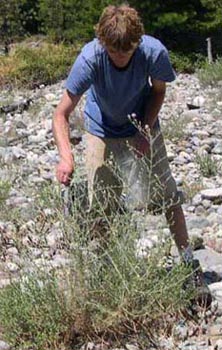
Spotted knapweed
Largest Infestation in California 99% Under Control!
The Salmon River's spotted knapweed infestation was the largest in California by acreage. Not anymore! This invasive species from Europe and Asia has been all but eradicated throughout the Salmon River watershed.
The infestation is believed to have begun during the massive wildfires of 1987 when fire equipment and personnel brought to the Salmon River unknowingly spread knapweed seeds at fire camps and water tanker fill sites.
Despite the size of the infestation, SRRC has had great success in controlling spotted knapweed using manual control methods.
Managed Sites
Over 270 knapweed sites are currently being managed by the SRRC. These sites are spread out along 70 miles of river, over 300 miles of roads and trails, and in 400 acres of upslope habitat. A total of approximately 1,500 acres are surveyed and managed annually.
The status of each site is recorded at every visit and is tracked in a database.
Progress in Eradicating Knapweed: 99% Reduction!
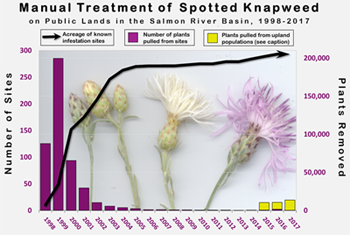 Knapweed plants dug and sites
managed, 1998-2017
Knapweed plants dug and sites
managed, 1998-2017
Over twenty years SRRC’s spotted knapweed program significantly decreased plant populations while rates of new site discovery reduced. Purple bars represent river bar populations, while yellow bars represent recently discovered populations at disturbed upland sites.
These new sites, typically found using post-wildfire survey funds, are large populations in old logging units, large firelines, and along cattle routes to wilderness grazing allotments.
Due to their physical separation and differing modes of entry and spread, they are shown as distinct from the populations at older river bar sites.
Three Pass System
We use a three pass system to schedule and monitor ground work.
- First pass (February to May): crews visit all sites inventoried in the past year. Any visible knapweed is uprooted and left to dry in the sun.
- Second pass (May to July): crews search for new populations between known infestation areas on both sides of the river. The crews eliminate all visible adult and immature plants at both new and old sites.
- Third pass (July to September): crews sweep both sides of the river from the North Fork to the confluence of the Salmon and Klamath Rivers, covering 36 miles. On average, 200 feet on each side of the river is surveyed. The emphasis is on finding new populations and eliminating all plants to prevent seed maturation.
An extra pass takes place in October on the North Fork.
How to Control Spotted Knapweed on Your Property
- Identify the extent of the infestation. You will need to remove all plants, regardless of size. Look hard!
- Observe the individual plants. If there are old seed heads or flowering heads, carefully clip them directly into a bag. Be careful not to spill seeds. Safely burn the bagged seeds.
- Using a pointed metal tool such as a crow bar, grab the plant and dig around the crown to expose as much root as possible. Pull gently and follow the root as far as it goes--this may be several feet. The object of digging is to remove as much of the root as possible. Pull the plant and leave it exposed to the sun to dry.
- Continue to monitor the area, looking for sprouts and new plants. Any remaining roots will resprout, often shooting off numerous new plants with a lush and large development of leaves.
Salmon River Noxious Weed Identification Guide
Spotted knapweed (Centaurea maculosa)
Identifying Characteristics
- Habit: biennial or short lived perennial with a stout taproot
- Flower color: pinkish purple with fuzzy white center
- Flowers: July to September
- Plant height: 8 inches to 6 feet
- Stems: One or more, branching
- Basal leaves: feathery, lobed
- Bracts: tipped with dark tinged
- Similar to meadow knapweed
- CA State Pest Rating: Class A
Occurrence
From 400-4000' elevation, adaptable to a variety of habitats. Moist areas, river bars, dry roadsides, in the shade or sun.
Notes
Spotted and diffuse knapweed were first discovered by the USFS on the Salmon River in 1997, with concentrated populations in the Kelly Bar vicinity on the North Fork. Both species are rated "Class A Pests" by the State of California, which mandates eradication as described in county and state health codes. Public land managers originally promoted intensive herbicide applications to control knapweed. SRRC and the local community responded with a very effective chemical-free control program that has significantly reduced or eliminated knapweed plant concentrations at over 260 sites.
More Info
California Department of Food & Agriculture
www.cdfa.ca.gov/plant/ipc/encycloweedia/weedinfo/centaurea.htm
Wikipedia
en.wikipedia.org/wiki/Centaurea_maculosa
Oblong spurge (Euphorbia oblongata)
Identifying Characteristics
- Habit: perennial
- Flower color: yellow
- Blooms: Spring/summer
- Plant height: up to 2 feet
- Stems: ascending to erect, hairy, becoming red with age, secretes latex when broken
- Leaves: sessile; blade oblong to lanceolate, tip obtuse, margin finely toothed
- Inflorescences: involucre 0.5 to 1 inch, bell-shaped, glabrous
Occurrence
Disturbed areas, weedy fields, and roadsides. First found on the mainstem Salmon River in 2012 and known to occur at Grants Bluff, Indian Bottom, and near Achilles Rapid on river right.
Notes
Native to Eurasia. May cause minor skin irritation. SRRC has been working to swiftly contain the spread of oblong spurge along the Salmon River, using rafts and kayaks to access the far banks of the river between class III-IV+ rapids in the vicinity of Cascade Falls and Achilles Rapid.
More Info
SRRC's Oblong Spurge Poster (PDF)
California Depatment of Food & Agriculture
www.cdfa.ca.gov/plant/ipc/encycloweedia/weedinfo/euphorbia.htm
Italian thistle (Carduus pycnocephalus L.)
Identifying Characteristics
- Habit: annual
- Flower color: pink to purple
- Blooms: May to July
- Plant height: 8 inches to 6.5 feet
- Stems: winged with spines, glabrous to slightly woolly
- Basal leaves: 4-6 inches long, lobed
- CA State Pest Rating: Class C
Occurrence
It is found in disturbed areas, often with fertile soils or soils with a relatively high pH (> 6.5). The only known infestation of Italian thistle in the Salmon River watershed is in the immediate vicinity of Forks of Salmon.
Notes
SRRC has been working to eradicate the single population of Italian thistle in the watershed and the effort is showing great results.
More Info
California Department of Food & Agriculture
www.cdfa.ca.gov/plant/ipc/encycloweedia/weedinfo/carduus.htm
Wikipedia
en.wikipedia.org/wiki/Carduus_pycnocephalus
Sulfur cinquefoil (Potentilla recta)
Identifying Characteristics
- Flower color: pale yellow
- Flowers: 5 heart-shaped petals
- Blooms: June to July
- Plant: one to seven stems are upright with some branching near the top, and up to 3 feet tall. Distinguished by long, stiff hairs on stems and leaves that stick straight out from the surface.
- Leaves: There are numerous leaves on the stems, 5-7 leaflets with distinctly toothed edges.
- CA State Pest Rating: Class A
Occurrence
Sulfur cinquefoil infests roadsides and is highly competitive. It thrives in dry and compact soil conditions.
Notes
Look-alike native graceful or slender cinquefoil (Potentilla gracilis) has short hairs that lie flat on the stems and leaves and brighter yellow flowers. Sulfur cinquefoil seeds also have a net-like pattern on them, compared with the smooth seed coat of the native graceful cinquefoil. Low infestation on the Salmon River.
More Info
US Department of Agriculture Natural Resources Conservation Service
www.plants.usda.gov/core/profile?symbol=PORE5
Wikipedia
en.wikipedia.org/wiki/Potentilla_recta
Marlahan mustard (Isatis tinctoria L.)
Identifying Characteristics
- Habit: erect biennial
- Flower color: bright yellow
- Blooms: April to June
- Plant height: up to 4 feet
- Stem leaves: alternate, sessile, broad to narrowly arrowhead-shaped
- Seed pods: black, 0.5 inches long
- CA State Pest Rating: Class B
Occurrence
There is a high infestation of Marlahan mustard throughout the Salmon River watershed, including wilderness areas and river bars. Often grows on dry, rocky or sandy soils.
Notes
Also known as dyer's woad. Marlahan mustard was cultivated for several centuries in Europe as a medicinal herb and, until trade routes with India were opened, it was the only source of blue dye. Evidence of its use by humans extends back to Neolithic times. Foliage contains compounds that appear to have insecticidal and fungicidal properties. The Scott Valley has a remarkable infestation of Marlahan mustard and is the likely origin of the populations found on the Salmon River.
More Info
California Department of Food & Agriculture
www.cdfa.ca.gov/plant/ipc/encycloweedia/weedinfo/isatis.htm
Wikipedia
en.wikipedia.org/wiki/Isatis_tinctoria
Yellow starthistle (Centaurea solstitialis L.)
Identifying Characteristics
- Habit: annual
- Flower color: bright yellow
- Flowers ringed with spines
- Blooms: May to August
- Plant height: up to 4 feet
- Stems: gray-green, rigid, branching
- Basal leaves: deeply lobed, sharply pointed
- CA State Pest Rating: Class C
Occurrence
There is a high infestation of starthistle throughout the Salmon River watershed, including wilderness areas. Starthistle came here through infested hay, vehicles, animals, and other vectors.
Notes
Starthistle grows quickly and is very competitive. It has a long tap root that enables it to thrive during dry, hot summers. It is versatile in its growth patterns, and can adapt to drought or low soil moisture content by producing smaller plants with fewer seeds during dry years.
The SRRC has begun to map locations of starthistle and we have removed satellite populations from roadsides and river bars. This is the beginning of our management of starthistle. After all known populations are mapped, we can then prioritize densities and control the population from the outside in.
Generally similar in appearance, Malta starthistle is found more rarely in the Salmon River watershed.
More Info
California Department of Food & Agriculture
www.cdfa.ca.gov/plant/ipc/encycloweedia/weedinfo/centaurea2.htm
Wikipedia
en.wikipedia.org/wiki/Centaurea_solstitialis
Scotch broom (Cytisus scoparius)
Identifying Characteristics
- Habit: perennial, leguminous shrub
- Flower color: golden yellow
- Blooms: late April to May
- Plant height: 2 to 7 feet
- Stems: up to 2 inches thick, tough
- Leaves: trifoliate leaves 0.1 to 0.5 inches long
- Seed pods: black, 1-2 inches long
- CA State Pest Rating: Class C
Occurrence
Here on the Salmon River, a low to medium infestation of Scotch broom occurs on roadsides (where it was once planted for erosion control) and disturbed areas such as old house sites and campgrounds.
Notes
Scotch broom is a prodigious seed producer. Seeds can survive in the environment for up to 80 years. Seeds are transported from place to place in mud stuck to vehicles, equipment, shoes and the feet of animals. Seeds may be carried via runoff from roads into streams and gullies. Scotch broom burns vigorously when ignited, creating an extreme fire hazard.
More Info
California Department of Food & Agriculture
www.cdfa.ca.gov/plant/ipc/encycloweedia/weedinfo/brooms.htm
Wikipedia
en.wikipedia.org/wiki/Scotch_broom
Puncture vine (Tribulus terrestris)
Identifying Characteristics
- Habit: annual
- Flower color: bright yellow, solitary
- Flowers: April to October
- Stems: highly branched, green to reddish-brown, prostrate and spreading radially from the crown on open ground to erect when shaded or competing with other plants
- Leaves: opposite, even-pinnate compound, 1.5 to 2 inches long, with 3-7 leaflet pairs per leaf and a small extension at the tip
- Seeds: extremely sharp, can puncture bicycle tires and shoes
Occurrence
Disturbed places, roadsides, cultivated fields, yards, waste places, walk ways. Grows best on dry sandy soils, but tolerates most soil types. Intolerant of freezing temperatures.
Notes
Puncturevine has not been present in this area for very long. Now is the time to control the spread before the seed bank becomes unmanageable. Also known as "goathead".
More Info
California Department of Food & Agriculture
www.cdfa.ca.gov/plant/ipc/encycloweedia/weedinfo/tribulus-terrestris.htm
Wikipedia
en.wikipedia.org/wiki/Tribulus_terrestris
White top (Lepidium latifolium L.)
Identifying Characteristics
- Habit: perennial
- Flower color: white
- Blooms: March to July
- Plant height: up to 2 feet
- Stems: erect, sparse to densely covered with short hairs
- Leaves: alternate, ovate to oblong, dull, scaly
- CA State Pest Rating: Class B
Occurrence
Often grows on moderately moist, alkaline to saline soils, but tolerates a wide range of soil types and moisture conditions. Prefers irrigated areas.
Notes
Also known as hoary cress. Native to Southwest Asia. It was likely introduced in multiple shipments of contaminated alfalfa seed from Turkestan. White top was first found in California in 1876 near Yreka.
More Info
California Department of Food & Agriculture
www.cdfa.ca.gov/plant/ipc/encycloweedia/weedinfo/lepidium.htm
Teasel (Dipsacus laciniatus L.)
Identifying Characteristics
- Habit: annual
- Flower color: white
- Blooms: July to September
- Plant height: 2 to 8 feet
- Stems: erect, stout, rough-hairy, longitudinally ridged
- Leaves: opposite; basal leaves irregularly cleft
- Inflorescences: heads, dense, egg-shaped to cylindrical, 1 to 4 inches tall, 1 to 2 inches wide, terminal on long stalks
Occurrence
Disturbed areas, weedy fields, wet ditches, and roadsides.
Notes
Native to Europe.
More Info
Invasive.org
www.invasive.org/browse/subject.cfm?sub=5545
Program Contact
Deja Malone-Persha
Plants Program Manager
Noxious Weed Project Manager
Salmon River Restoration Council
PO Box 1089
25631 Sawyers Bar Road (shipping only)
Sawyers Bar, CA 96027
phone: 530-462-4665
fax: 530-462-4664


Salmon River Restoration Council
PO Box 1089 | Sawyers Bar, CA | 96027
Salmon River (California)
530-462-4665
![]()
